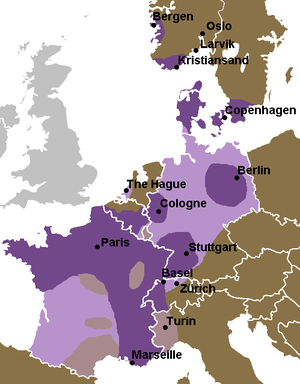This article needs additional citations for verification. (December 2015) |


Guttural R is the phenomenon whereby a rhotic consonant (an "R-like" sound) is produced in the back of the vocal tract (usually with the uvula) rather than in the front portion thereof and thus as a guttural consonant. Speakers of languages with guttural R typically regard guttural and coronal rhotics (throat-back-R and tongue-tip-R) to be alternative pronunciations of the same phoneme (conceptual sound), despite articulatory differences. Similar consonants are found in other parts of the world, but they often have little to no cultural association or interchangeability with coronal rhotics (such as [r], [ɾ], and [ɹ]) and are (perhaps) not rhotics at all.
The guttural realization of a lone rhotic consonant is typical in most of what is now France, French-speaking Belgium, most of Germany, large parts of the Netherlands, Denmark, the southern parts of Sweden and southwestern parts of Norway. It is also frequent in Flanders, eastern Austria, Yiddish (and hence Ashkenazi Hebrew), Luxembourgish, and among all French and some German speakers in Switzerland.
Outside of central Europe, it also occurs as the normal pronunciation of one of two rhotic phonemes (usually replacing an older alveolar trill) in standard European Portuguese and in other parts of Portugal, particularly the Azores, various parts of Brazil, among minorities of other Portuguese-speaking regions, and in parts of Puerto Rico, Cuba and the Dominican Republic.
- ^ Map based on Trudgill (1974:220)